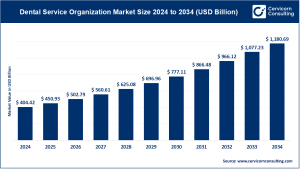Market Overview
The global patient monitoring devices market is expanding rapidly as healthcare shifts toward continuous and digitally connected care. Valued at USD 53.84 billion in 2025, the market is expected to reach USD 124.17 billion by 2035, fueled by rising chronic illnesses, an ageing global population, and fast-evolving technologies such as advanced sensors, wireless connectivity, and AI-driven analytics. This growth aligns with the increasing use of telehealth, home-based monitoring, and the need for seamless care from hospital to home.
Get a Free Sample: https://www.cervicornconsulting.com/sample/2811
Key Market Trends
1. Movement Toward Continuous and Hybrid Monitoring Across Care Settings
Patient monitoring is evolving from short-term, hospital-only use to continuous monitoring that spans hospitals, ambulatory centers, and homes. Remote patient monitoring (RPM), telehealth adoption, and early discharge programs are accelerating the use of connected wearables and long-duration monitoring tools, especially for chronic disease management, postoperative follow-up, and elderly care.
2. Growth of Wireless, Wearable, and Mobile-Based Monitoring Devices
Advances in miniaturized sensors, BLE connectivity, cloud integration, and extended battery life are boosting the adoption of wearable multi-parameter devices. Wireless telemetry and cable-free systems help improve patient comfort and clinical workflows while enabling clinicians to track vitals remotely in real time.
3. AI, Predictive Analytics, and Smart Clinical Algorithms
AI-driven monitoring solutions are redefining traditional vital-sign tracking. Predictive algorithms now help detect early deterioration, reduce false alerts, and identify subtle physiological trends. Tools such as early-warning scores, arrhythmia prediction, and automated alarm prioritization are becoming key differentiators in modern monitoring platforms.
4. Expansion of Industry Partnerships and Interoperable Ecosystems
Manufacturers, digital health companies, EHR providers, and cloud platforms are forming strategic alliances to build unified monitoring ecosystems. These collaborations support seamless data exchange between bedside monitors, wearables, remote sensors, and clinical systems—accelerating innovation and expanding enterprise monitoring capabilities.
5. Improved Reimbursement and Regulatory Support for Remote Monitoring
Regulators and payers across major regions have updated reimbursement frameworks to encourage the adoption of remote monitoring, chronic care management, and home-based follow-up. This support has boosted implementation of RPM programs across both urban and underserved areas.
Market Drivers
Growing Chronic Disease Burden and Ageing Populations
The rising prevalence of cardiac diseases, diabetes, hypertension, COPD, and neurological conditions drives substantial demand for continuous monitoring tools. As ageing populations grow worldwide, long-term monitoring—both invasive and non-invasive—has become vital for managing multiple comorbidities and reducing hospital reliance.
Rapid Expansion of Telehealth and Remote Care Models
Telemedicine has transformed care delivery, making home-based monitoring essential for virtual consultations. Devices tracking ECG, glucose levels, respiratory rate, oxygen saturation, and blood pressure support uninterrupted care without clinic visits.
Technological Breakthroughs in Sensors, Connectivity, and AI
Innovations in biosensors, mobile-health systems, AI algorithms, and cloud-based analytics are boosting device precision, lowering costs, and enabling new clinical applications such as real-time triage and predictive risk assessment.
Value-Based Care and Healthcare Cost Optimization
Health systems are increasingly focused on reducing inpatient stays, avoiding readmissions, and improving workflow efficiency. Continuous monitoring helps clinicians intervene early, improving outcomes while lowering costs.
Government-Supported Digital Health and Telemedicine Initiatives
National programs promoting telehealth, chronic disease management, and digital health infrastructure—especially across North America, Europe, India, and East Asia—are accelerating the deployment of advanced monitoring solutions.
Impact of Key Trends and Drivers
Hospital & ICU Settings
AI-enabled multi-parameter monitors, centralized dashboards, and wireless telemetry systems are enhancing workflow efficiency and clinical accuracy across ICUs, ORs, EDs, and general wards.
Home-Based & Ambulatory Care
Home monitoring is the fastest growing segment, driven by portable ECG devices, wearable multiparameter sensors, glucose monitors, and oxygen saturation trackers. RPM programs help reduce hospital load and support long-term care for chronic patients and seniors.
Product Segments & Clinical Applications
-
Cardiac monitoring remains the largest segment due to high cardiovascular disease rates.
-
Respiratory and hemodynamic monitoring are growing quickly due to rising chronic respiratory and perioperative care needs.
-
Neuromonitoring and fetal monitoring devices are gaining traction in specialty and outpatient settings.
Regional Market Outlook
-
North America dominates due to strong technological adoption and supportive reimbursement.
-
Asia-Pacific is the fastest-growing region driven by large populations, rising chronic diseases, and improving healthcare infrastructure.
-
Europe maintains steady growth supported by government digital health programs.
-
Latin America and Middle East/Africa show emerging potential through telehealth investments and modernization efforts.
Challenges & Opportunities
Key Challenges
-
High upfront and maintenance costs
-
Cybersecurity and data privacy risks
-
Limited device interoperability
-
Infrastructure gaps in low-resource regions
Key Opportunities
-
Expansion of remote monitoring and home healthcare
-
AI-driven predictive monitoring solutions
-
Low-cost device innovation for emerging markets
-
Integration of clinical-grade wearables with consumer health devices
Future Outlook
The patient monitoring devices market is set for robust long-term growth, with the market expected to rise from USD 53.84 billion in 2025 to USD 124.17 billion by 2035. Advancements in AI, hospital-to-home care models, and digital health infrastructure will continue to drive adoption. Future innovations will likely include intelligent monitoring ecosystems, expanded home-based solutions, clinically validated multiparameter wearables, advanced predictive algorithms, and personalized monitoring pathways.
To Get Detailed Overview, Contact Us – https://www.cervicornconsulting.com/contact-us

